The Fascinating Story of Cheddar Cheese in 2025
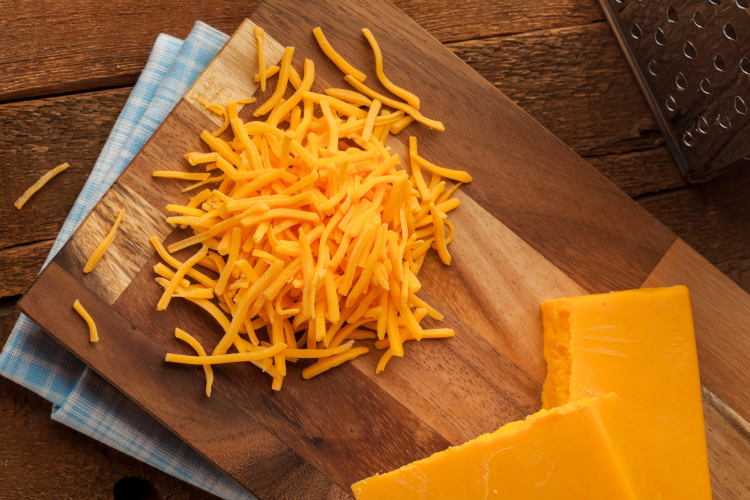
For many of us, cheddar cheese would be our desert island pick. It’s familiar, flavorful, and endlessly versatile. But have you ever stopped to wonder where it came from or why it tastes so different depending on the brand or style?
Cheddar cheese has a rich history that stretches back centuries, yet it remains one of the most beloved and versatile cheeses in the world today.
From humble beginnings in a quiet English village to starring roles in everything from soup to fondue, cheddar’s journey is just as flavorful as the cheese itself. Let’s dig into what makes cheddar so special, from how it’s made to how to enjoy it best.
Jump to Section
- What Is Cheddar Cheese?
- The Best Ways to Eat Cheddar Cheese
- Best Cheddar Cheese Recipes
- Is Cheddar Cheese a Healthy Cheese?
- Cheddar Cheese FAQs
What Is Cheddar Cheese?
The History of Cheddar Cheese
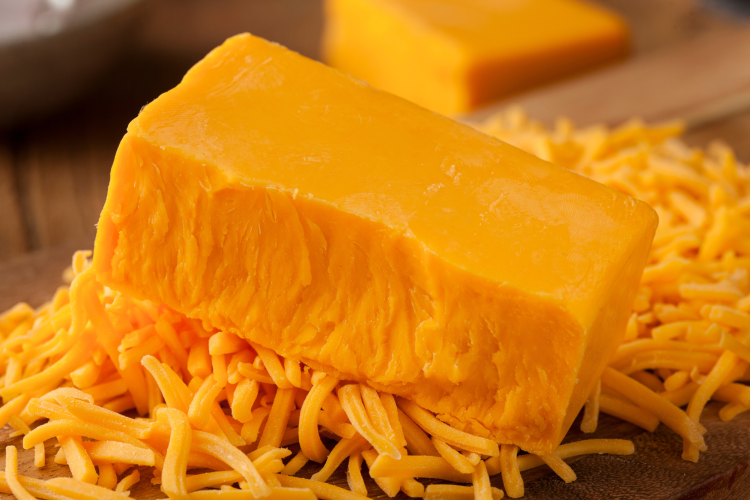
Cheddar cheese might be made all over the world today, but it all started in a small village called Cheddar in Somerset, in the southwest of England. That’s where this famous cheese got its name.
Back in the Middle Ages, cheesemakers in the Cheddar Gorge area used nearby caves to age their cheese, taking advantage of the cool, consistent temperatures. Over time, Cheddar became a favorite not just for its flavor but also because it was easy to transport and stayed fresh for a long time.
Before long, cheddar became a favorite among England’s upper class and as its reputation grew, cheddar production expanded beyond Somerset to other parts of England and, eventually, to countries around the world.
Unlike some specialty cheeses from Europe, the name “cheddar” isn’t protected by a protected designation of origin or PDO stamp. That means cheesemakers from anywhere in the world can label their product as cheddar, even if it’s made far from England.
However, in 2007, a specific version called West Country Farmhouse Cheddar earned special recognition from the European Union. So now, only cheddar made using traditional methods with local milk from Somerset, Dorset, Devon or Cornwall can carry that specific name.
Cheddar cheese has been made for hundreds of years, and while the tools have changed, the heart of the process remains the same. It starts with fresh milk and a little ingredient called rennet, which helps the milk thicken and form curds.
Once the curd sets, it's cut into small cubes, usually about the size of a pea to a jellybean, using special wire knives.
Next comes a step that makes cheddar unique: cheddaring. This process involves stacking blocks of curd on top of each other. The weight helps push out extra liquid, called whey. The cheesemaker then continues to flip and restack the curds until they become firmer and slightly crumbly.
After that, the curd is chopped into smaller bits, sprinkled with salt and packed tightly into molds called truckles. These are left to age, and this is where cheddar develops its flavor.
A cheddar aged for about three months is considered mild, while aged cheddar is stored for 12 to 24 months. It becomes sharper in flavor, drier and crumblier, making it perfect for cheese boards or pairing with wine and craft beer.
There are also lots of fun variations. Smoked cheddar has a deep, smoky flavor, either from real smoking or added flavoring, while flavored cheddars include ingredients like herbs, jalapeños, truffle or garlic for an extra kick.
Then there’s white cheddar, which is made the same way as yellow cheddar but without annatto, a plant-based dye that gives many cheddars their classic orange tint. The flavor is the same; it’s just a matter of color.
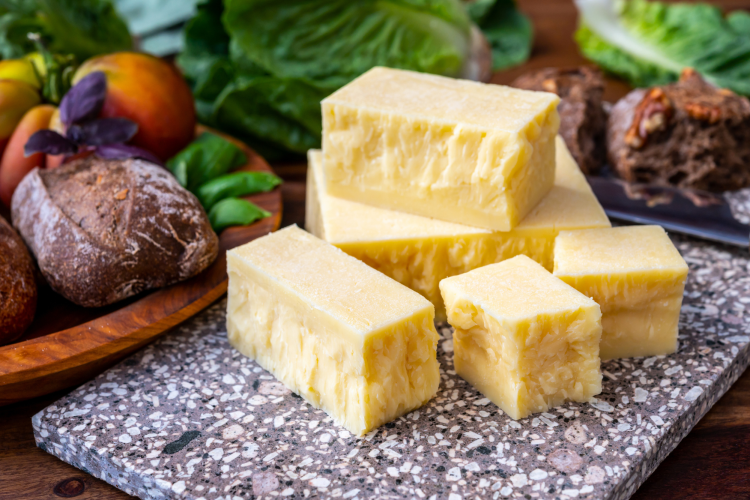
One of the most unique cheddars still comes from Somerset itself. The Cheddar Gorge Cheese Company continues to age its wheels inside the original caves of the region.
These cheeses are the only ones still made and matured in Cheddar, and the cave's humidity helps develop natural molds and deep, complex flavors on the rind. However, cheddar can be matured in many different ways.
Commercial cheddar cheese brands often sell milder versions that are rindless and uniform in texture, ideal for cheddar cheese slices you can use every day. Meanwhile, artisanal cheesemakers may wrap their wheels in cloth or coat them in wax.
Cloth-wrapped cheddars can breathe, allowing them to develop an earthy aroma and a crumbly bite. Waxed cheeses, by contrast, stay a little softer and tend to have a sweeter and smoother taste.
How long cheddar cheese lasts depends on a few things, like how old it is, how it’s stored and whether the package has been opened. If it’s still sealed, cheddar cheese can stay fresh for several months as long as it’s kept in a cool, dry spot like your fridge.
Once you open it, it’s important to keep the cheese wrapped tightly in plastic wrap or stored in an airtight container. This helps it stay moist and keeps it from picking up odors from other foods. When stored properly in the refrigerator, opened cheddar cheese will usually stay good for up to a few weeks.
If you notice a bit of moisture inside the package of your naturally made cheddar cheese, don’t worry — it’s totally normal. This happens due to a natural process called syneresis, where proteins in the cheese release some of their moisture over time.
It doesn’t mean anything is wrong with the cheese. In fact, it’s part of how cheddar develops that sharp, crumbly texture so many of us love. To keep your cheese in great shape, just wipe off any excess moisture with a clean paper towel.
Then, rewrap it in fresh parchment or wax paper and store it in the refrigerator. This helps the cheese breathe and continue to age gracefully while keeping it fresh and flavorful.
What Type of Cheese is Cheddar Cheese?
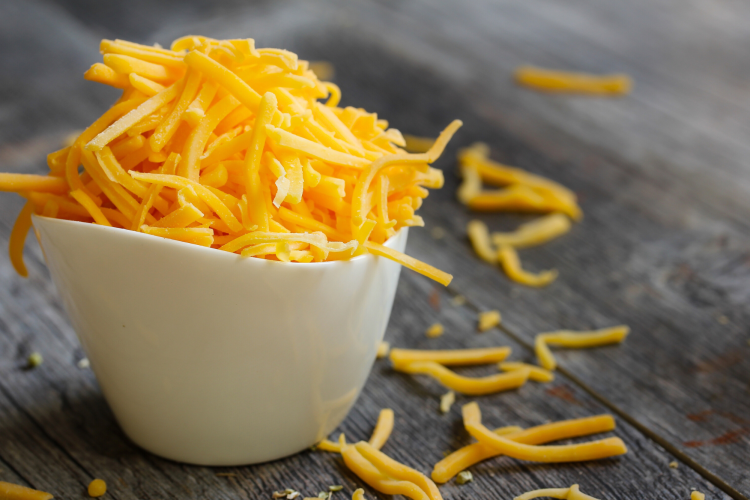
Cheddar cheese is a firm, natural cheese that’s usually off-white, yellow or orange in color. Its flavor ranges from mild to sharp and the key difference between the two is how long the cheese has been aged.
Mild cheddar is aged for just a few months, while sharp cheddar is aged for a year or more, which allows the flavor to become more intense, tangy and complex.
Younger cheddar might smell slightly sweet or buttery, while aged cheddar can develop a stronger, more earthy aroma, sometimes even a bit funky in the best way. Most cheddar is made from cow’s milk, but some versions use goat’s or sheep’s milk for a unique twist on the classic flavor.
The Best Ways to Eat Cheddar Cheese
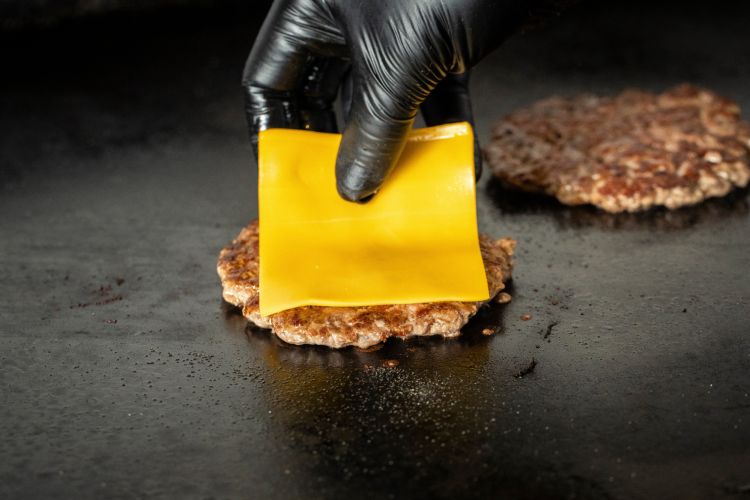
Cheddar cheese is one of the most versatile ingredients you can keep in your fridge or pantry. From fresh, aged, shredded or even cheddar cheese powder, there's no shortage of delicious ways to enjoy it.
Young cheddar cheese slices melt beautifully thanks to their higher moisture content, so they’re ideal for grilled cheese sandwiches or layered into a fresh deli sandwich. And when it comes to burgers, nothing beats a slice of cheddar gently melting over a hot patty.
For dishes like mac and cheese, you can customize your cheddar based on the flavor and texture you're aiming for. A mild cheddar will give you that ultra-creamy melt, while a sharp or aged cheddar adds a stronger, more complex flavor.
If you're making a quick stovetop version, shredded cheddar cheese melts fast and blends smoothly with cream or milk. Cheddar cheese powder, on the other hand, is a convenient pantry option that you can sprinkle over popcorn, mix into pasta or use to add a cheesy kick to homemade snacks. It's especially handy when you're camping or cooking without a fridge.
Cheddar also pairs well with drinks, especially if you’re serving it on a cheese board. A sharp, aged cheddar goes great with full-bodied red wines like pinot noir, cabernet sauvignon or malbec.
If you prefer beer, try it with an English cider or a hoppy IPA — both bring out the tangy notes in stronger cheddars. If you want to build a unique cheese plate, consider adding Stilton blue cheese and British Camembert alongside a mature cheddar for a trio of classic flavors.
While not traditional for a cheese plate, soft options like cottage cheese or ricotta cheese can be served on the side with fruit or crusty bread for a creamy contrast.
Best Cheddar Cheese Recipes
Cheddar cheese offers endless possibilities in the kitchen, from comforting classics to impressive party dishes. Here are some crowd-pleasing cheddar cheese recipes to inspire your next meal.
White Cheddar Mac and Cheese
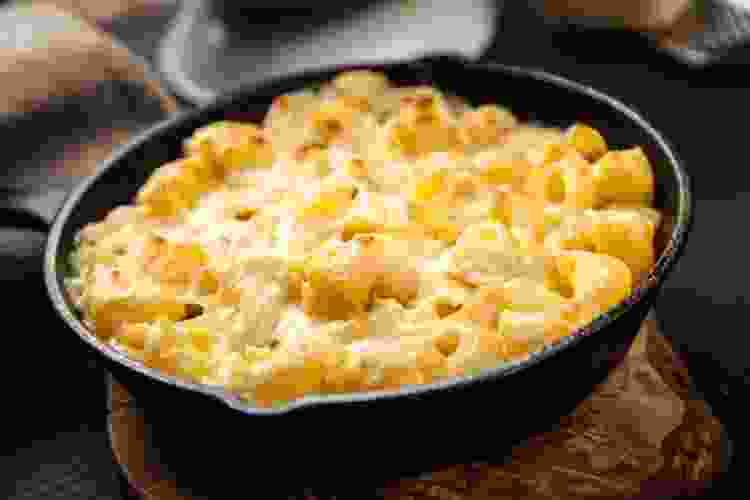
Creamy white cheddar mac and cheese is comfort food at its finest, and it doesn’t even need to go in the oven. Start by making a simple roux with butter, garlic and flour, then slowly whisk in milk and heavy cream until smooth.
Add salt, a touch of hot sauce and cracked black pepper to enhance the flavor. Stir in plenty of shredded white cheddar cheese until melted and creamy, then mix in freshly cooked pasta.
Cheddar Fondue
One of the most fun and delicious ways to enjoy cheddar is by turning it into fondue. It’s perfect for dipping crusty bread, roasted vegetables and even apple slices.
Using high-quality shredded cheddar cheese gives the fondue a smooth texture and it makes for a cozy, shareable dish that’s great for gatherings or a special night in.
Broccoli Cheddar Soup
For this beloved cheddar cheese recipe, always start with freshly shredded cheddar cheese rather than pre-packaged options and opt for sharp or extra-sharp cheddar for maximum flavor impact.
The seasonings truly elevate this soup as well. Think ground mustard powder to enhance the cheesy flavor and a light dusting of paprika for a subtle color that complements the rich soup perfectly.
Is Cheddar Cheese a Healthy Cheese?
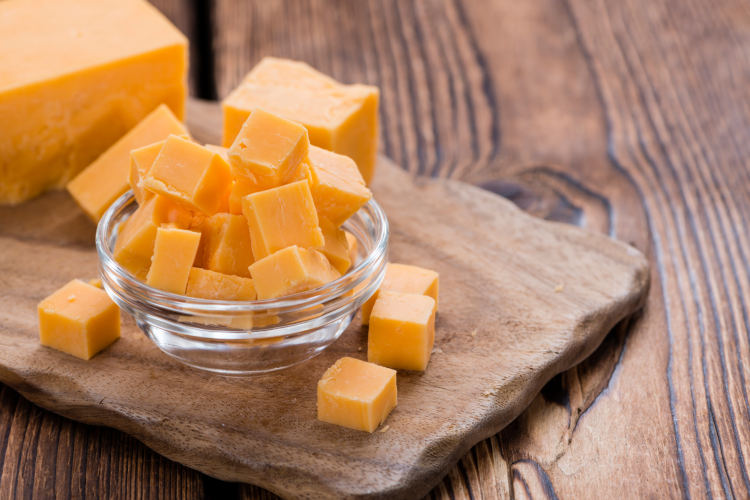
Cheddar cheese can definitely be part of a healthy diet, even though it has a bit more fat than lighter cheeses like mozzarella or feta. A typical one-ounce serving of cheddar contains around 115 calories but it also delivers about 7 grams of protein, making it a great addition to high-protein meals that help keep you feeling full and satisfied.
In addition to being a good source of protein, cheddar is also rich in calcium, which supports strong bones and it contains vitamin K2, a nutrient that plays an important role in heart and bone health.
Vitamin K2 helps guide calcium into your bones and teeth as well, while keeping it from building up in your arteries, which is a good thing for your circulation.
What’s more, studies in the National Library of Medicine have found that cheddar tends to be low in lactose because during the cheesemaking process, most of the whey is drained off.
So even if you're sensitive to lactose, you might still enjoy cheddar without discomfort, especially aged varieties. In fact, cheddar that’s been aged for over a year is considered practically lactose-free.
Cheddar Cheese FAQs
What Are the Three Types of Cheddar?
Cheddar cheese comes in three main types: mild, sharp and extra sharp. The difference between them all comes down to how long the cheese is aged. Mild cheddar is typically aged for about three to six months, giving it a creamy texture and a gentle, easygoing flavor.
Sharp cheddar is aged between nine and 12 months, which allows the flavors to deepen and develop a tangier bite. Extra sharp cheddar takes things even further, often aged for up to two years or more.
Some specialty varieties are even aged for 10 years, creating a bold, crumbly cheese with strong, complex flavors.
Why Is Cheddar Called American Cheese?
You may have heard people refer to cheddar as “American cheese,” and there’s a reason for that. Although cheddar got its start in England, it’s now made all around the world and each region gives it its own unique character.
Traditional English cheddar, especially the kind made in Somerset, is known for its rich, layered flavors that often have earthy or grassy notes. American cheddar, by comparison, tends to be milder and creamier.
This difference comes down to a few key factors: the type of cows used, what those cows eat and the specific techniques cheesemakers use during production. So while it may have started as an English classic, cheddar has definitely found a second home in America.
Whether you enjoy it mild and creamy or aged and sharp, cheddar has something to offer everyone. It’s a classic cheese that brings comfort to everyday meals and adds depth to gourmet dishes.
So next time you unwrap that familiar yellow or white wedge, remember, you’re tasting a little piece of history. To learn even more, check out other experiences happening on Classpop!

